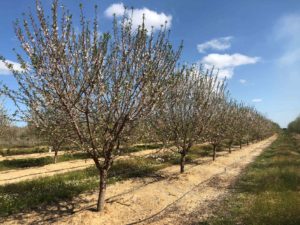March is a month full of surprises. Weather can be highly variable, with rain, risk of frost, and heat waves all being possible. Below are some points to consider as the season progresses.
Ongoing frost concerns. Frost conditions can occur through the end of March. Maintain a watchful eye on the weather conditions to reduce the risk of any frost event. Critical temperatures after petal fall are around 28F (-2.2C), and temperatures at or below 28F for an extended period will cause crop loss. Micro-irrigation can increase orchard temperature by a few degrees, with higher flows of water providing a greater warming effect. More on frost mitigation can be found here.
With irrigation occurring during multiple frost events, it is common to see trees push slow and with pale green growth. This is due to saturated rootzones that lead to loss of fine feeder roots and low micronutrient uptake. Soil irrigation levels should be monitored, and irrigation withheld until stored soil moisture begins to drop. Furthermore, nitrogen applications should not occur during the period of frost risk as running water for extended periods of time will leach nitrogen out of the rootzone.
Crop losses from frost are hard to define in early March. Frost affected flowers will have blackened tissue inside the ovary, or flowers may appear blighted and remain on the tree. Trees will slightly compensate for loss of flowers with a slight increase in fruit set percentage of the remaining flowers as well as greater nut size. Therefore, in areas of minimal damage, the impacts might not be observed. In areas with losses greater than 10%, yield reductions should be expected. If frost damage is suspected, it is important to contact any insurance company as soon as possible and trim the early season fertilizer applications until a better estimate of crop load can be made.
Nitrogen applications. It seems every year, operations start applying nitrogen earlier. Although it is important to fertilize, fertilizing too early will increase the risk of leaching, reducing nitrogen use efficiency and wasting money. Nitrogen uptake by the tree really does not occur until full leaf expansion (late March), with very little nitrogen being utilized prior. The tree during this period is running on stored reserves from last fall. Small applications may be considered, but large “slugs” should be avoided. Furthermore, the use of ammonium-based fertilizers should be considered over nitrate-based fertilizers due to reduced leaching and the ability for the plant to actively take up ammonium.
Do you really need more P? The answer is nearly always “no” in California, and “yes” in Australia and Europe. Almonds utilize low rates of phosphorus through the year. Depending on crop load, the amount is around 25-40 lbs of P2O5 per acre (22-45 kg/ha). Within California, any compost application will probably provide the needed amounts. To determine if more P is needed, perform a soil analysis. Generally, soil levels within 20-40 ppm and 10-20ppm for Bray P1 and Olsen analysis, respectively. If soil levels are at or above this, P applications can be reduced or eliminated. If levels are high, but tree leaf analysis is indicating deficiency, more P may not be needed, but rather the addition of microorganisms that improve the tree’s access to the P. In these cases, consider performing a microbial test along with the analytical analysis to determine how to proceed. There is an increasing number of businesses that provide this type of service. More information on P and almonds can be found here.
Fungicide considerations. Most flower and fruit diseases need extended periods of leaf wetness for infection to occur. Sprays should be made every 10-14 days during periods of frequent, heavy rain. In times of infrequent rain, fungicide applications can be reduced.
foliar diseases are different than fruit diseases, and disease can occur even without rain. Scab, Alternaria, and Rust can be problematic even in dry conditions. To prevent Scab, fungicides must be timed between 2-5 weeks post petal fall. During this period, the scab lesions from last year are producing spores, which will infect and show symptoms in late April and May. Rust treatments are typically not necessary until April through May, usually with one application in April and the other in the “May Spray” . Alternaria tends to be bad in blocks with a lot of humidity and dew. Weather stations with a leaf wetness sensor should be established within these blocks to provide monitoring and the ability to use the DSV model.


D
March 15, 2022can a quater inch of rain trigger antrachnose
Davidd
March 26, 2022Yes, it can – especially if the rain is warm. Since anthracnose survives in the wood, it will remain difficult to manage and can be problematic with any rain event.
David
Steve Lenander
March 18, 2022Great as always!
Davidd
March 26, 2022Thanks Steve.
David